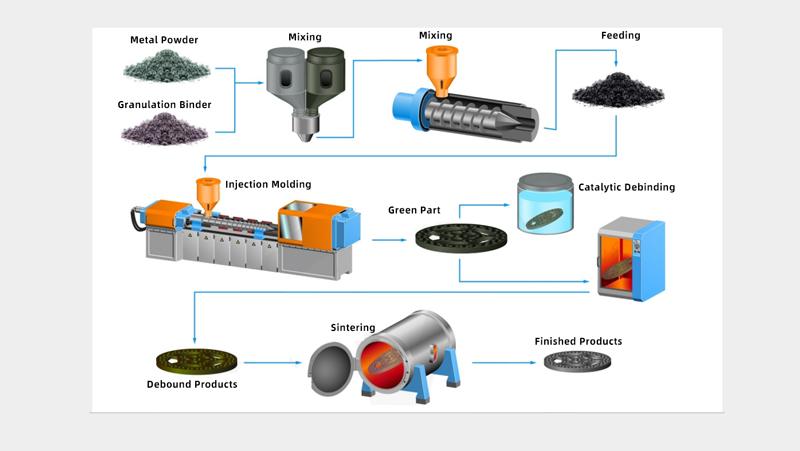What is Metal Injection Molding?
Metal Injection Molding (MIM) is a high-precision manufacturing process combining powder metallurgy and plastic injection molding. By mixing micron-sized metal powders with binders, injecting them into molds, debinding, and sintering, MIM produces complex, high-density metal parts.
In simple terms, the MIM process involves:
Mixing: Metal powder (e.g., stainless steel, titanium) with thermoplastic binders.
Molding: Injecting the feedstock into molds to form “green parts.”
Debinding: Removing 90%+ of the binders.
Sintering: High-temperature densification to create final parts.

Metal Injection Molding Materials
Metal Injection Molding supports various materials. Common choices include:
Stainless Steels (60%+ of MIM applications)
1. 316L Stainless: Corrosion-resistant for medical/marine parts.
17-4PH Stainless: Heat-treatable to HRC 40+ for high-strength components.
2. Titanium Alloys
Ti-6Al-4V: Lightweight for aerospace/medical implants.
CP-Ti: Biocompatible for surgical tools.
3. Tungsten Alloys
W-Ni-Fe: High density (17 g/cm³) for radiation shielding.
4. Soft Magnetic Alloys
Fe-50Ni: High permeability for sensors and motors.
Pro Tip: Balance cost, performance, and manufacturability when selecting MIM materials. Check Available Materials for MIM
What Products Are Best Suited for Metal Injection Molding?
Metal Injection Molding excels at producing:
1. Complex Small Parts
Features: Thin walls (as low as 0.3mm), threads, intricate geometries.
Examples:
Medical: Surgical forceps, dental brackets
Electronics: SIM card ejectors, micro-connectors
2. High-Precision Components
Tolerances: ±0.3%-0.5% (better than casting).
Examples:
Automotive fuel injectors (±0.1mm tolerance)
Watch gears
3. Mass-Produced Parts
Optimal Volume: 5,000–1M units/year.
Examples:
Power tool gears (500k units/year)
Firearm triggers
Avoid MIM for:
✗ Oversized parts (typically <100mm)
✗ Low-budget prototypes (<500 units – consider 3D printing)
Which products are suitable for manufacturing with Metal Injection Molding (MIM)?
Why Choose Metal Injection Molding?
|
Advantage |
vs. Traditional Methods |
|
Design Freedom |
Supports more complex geometries than CNC |
|
40% Cost Reduction |
More economical than casting for mid-volume |
|
95% Material Usage |
Minimizes waste vs. machining |
Industry Insight: The global MIM market is projected to reach $5.8B by 2028 (Grand View Research).
FAQs
Q1: How strong are MIM parts?
A: Sintered density reaches 97%-99%, matching forged part strength. View Material Test Reports
Q2: How small can MIM parts be?
A: Current minimum feature size: 0.1mm (e.g., micro-surgical needles).
Q3: What’s the MIM production timeline?
A: Typically 8-12 weeks from design to mass production.
Conclusion: The Value of Metal Injection Molding
Metal Injection Molding reshapes manufacturing for industries like healthcare, automotive, and electronics by enabling:
✔ Complex small metal parts
✔ High-precision mass production
✔ Cost-effective use of challenging materials (e.g., titanium)
Consult MIM Experts Now for custom solutions!
